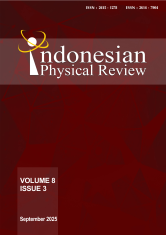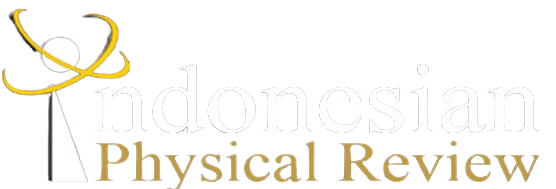CHARACTERIZATION OF GEOTHERMAL POTENTIAL USING 2D MAGNETOTELLURIC INVERSION AT TELAGA TUJUH WARNA, LEBONG REGENCY, BENGKULU PROVINCE, INDONESIA
DOI:
10.29303/ipr.v8i3.478Downloads
Abstract
The Telaga Tujuh Warna area in Lebong Regency exhibits geothermal manifestations such as hot water, mud craters, and fumaroles. This research aims to characterize the geothermal potential using 2D Magnetotelluric (MT) inversion. Measurements were conducted with the ADU-07e Magnetotelluric device, involving a 16-hour measurement period. Data collection followed the sounding principle with three frequency levels: high (4096 Hz), medium (1024 Hz), and low (128 Hz), spaced approximately 500 meters apart. Analysis confirms the consistency between 1D and 2D resistivity models, generating a resistivity distribution cross-section. Key findings include: (1) a low-resistivity cap layer (20–40 Ω-m) at approximately 1 km depth; (2) a medium-resistivity reservoir (40–160 Ω-m) at depths of 1–2 km; (3) a high-resistivity geothermal resource (>300 Ω-m) at depths of 1–2.5 km; and (4) a zone with very low resistivity values (2–16 Ω-m) at depths less than 1 km, potentially indicating a fumarole emitting hot water vapor and gas through rock fractures. These findings aim to advance geothermal exploration in Lebong Regency and support Indonesia's renewable energy objectives.
Keywords:
Geothermal Magnetotelluric method Resistivity Lembong regencyReferences
A. Brisman and N. South, “Green Criminology and Environmental Crimes and Harms,†Sociol. Compass, vol. 13, no. 1, pp. 373–390, 2019.
R. P. Rumahorbo and H. Nursadi, “1) 2) 1,2),†vol. 31, no. 1, pp. 185–202, 2023.
A. I. dan Hadi and K. S. Brotopuspito, “Pemetaan Percepatan Getaran Tanah Maksimum Menggunakan Pendekatan Probabilistic Seismic Hazard Analysis (Psha) Di Kabupaten Kepahiang Provinsi Bengkulu,†Berk. Fis., vol. 18, no. 3, pp. 101–112, 2015.
S. E. Lestari, A. Yunita, R. A. Rahman, Refrizon, and N. Sugianto, “Aplikasi Metode Magnetik Pada Pemetaan Sumber Panas Bumi di Kawasan Wisata Air Putih, Lebong, Bengkulu,†Newton-Maxwell J. Phys., vol. 3, no. 2, pp. 71–76, 2022.
I. D. Putra, R. A. F. Nasution, and A. Harijoko, “Aplikasi Landsat 8 Oli/Tirs Dalam Mengidentifikasi Altrasi Hidrotermal Skala Regional : Studi Kasus Daerah Rejang Lebong dan Sekitarnya, Provinsi Bengkulu,†Kebumian, vol. 2, no. December, pp. 56–63, 2017.
N. A. Adistia, R. A. Nurdiansyah, J. Fariko, V. Vincent, and J. W. Simatupang, “Potensi Energi Panas Bumi, Angin, Dan Biomassa Menjadi Energi Listrik Di Indonesia,†TESLA J. Tek. Elektro, vol. 22, no. 2, p. 105, 2020.
A. R. Al Ansory et al., “Delineasi Nilai Resistivitas Di Lapangan Panas Bumi Tambang Sawah Menggunakan Metode Magnetotellurik,†Bul. Sumber Daya Geol., vol. 18, no. 3, pp. 145–154, 2023.
D. Hermawan and L. A. Permana, “Keprospekan Panas Bumi Gunung Lawu Berdasarkan Kajian Vulkanostratigrafi,†Bul. Sumber Daya Geol., vol. 13, no. 3, pp. 199–213, 2018.
C. N. Dewi, S. Maryanto, and A. Rachmansyah, “Sistem Panasbumi Daerah Blawan, Jawa Timur Berdasarkan Survei Magnetotelurik,†J. Ris. Geol. dan Pertamb., vol. 25, no. 2, p. 111, 2015.
B. B. Timothy and N. L. I, “A review of the application of telluric and magnetotelluric methods in geophysical exploration,†vol. 1, no. 1, pp. 35–47, 2020.
K.- Karno, Y. Arman, and Z. Zulfian, “Pemodelan 1-D Pada Data Magnetotellurik Menggunakan Metode Algoritma Genetika,†Prism. Fis., vol. 10, no. 3, p. 214, 2023.
H. Raihana, K. Nazli, Suhendra, Refrizon, and Halauddin, “Tinjauan Fisik Indonesia,†vol. 6, 2023.
A. Kausari et al., “Indonesian Physical Review,†Indones. Phys. Rev., vol. 7, no. 2, pp. 250–258, 2024.
M. Farid, A. I. Hadi, and L. P. Sari, “Investigation of Geothermal Using Magnetotelluric Method in Babakan Bogor, Bengkulu Province, Indonesia,†Indones. J. Geosci., vol. 8, no. 2, pp. 221–231, 2021.
M. Farid, Refrizon, D. Oktiana Andeska, and A. Ismul Hadi, “Stratification characteristics of subsurface rock structure geothermal manifestations at Telaga Tujuh Warna Bukit Daun, Bengkulu, Indonesia using magnetic methods,†J. Phys. Conf. Ser., vol. 2498, no. 1, 2023.
I. N. Dien, S. Sulistyani, A. Handaru, D. S. Sayudi, and A. B. Santoso, “Interpretasi Bawah Permukaan Gunung Merapi dengan Metode Magnetotellurik,†J. Lingkung. dan Bencana Geol., vol. 11, no. 3, pp. 143–150, 2020, doi: 10.34126/jlbg.v11i3.225.
R. J. Marcellina, H. Johan, A. S. P. Sari, A. A. Nazari, T. S. J. Waini, and I. Marlina, “Pemanfaatan Sumber Daya Alam Kabupaten Lebong: Sumber Daya Pangan Rebung Bambu sebagai Bahan Baku Utama Pembuatan Lemea (Makanan Tradisional Kabupaten Lebong),†BIOEDUSAINSJurnal Pendidik. Biol. dan Sains, vol. 7, no. 1, pp. 46–57, 2024.
A. I. Hadi, M. Farid, L. Z. Mase, Refrizon, R. Mulyasari, M. A. Nabhan, D. I. Fadli, E. Putriani, and E. Sumanjaya, “Mapping landslide vulnerability using subsurface rock elastic parameters: Acase study of Lebong Regency, Bengkulu,†Kuwait Journal of Science., vol. 52, no.2, pp.1, 2025.
D. S. E. Mukazairo, R. Refrizon, and N. Sugianto, “Peta Anomali Magnetik Daerah Mineralisasi Emas Di Desa Tambang Sawah Kecamatan Lebong Utara Berdasarkan Pengukuran Magnetik,†Newton-Maxwell J. Phys., vol. 1, no. 1, pp. 19–24, 2020.
M. H. H. Zajuli and R. Oktavitania, “Geokimia Organik Serpih Hidrokarbon Berumur Eosen di Daerah Sumatera Bagian Tengah Organic Geochemistry of the Eocene Hidrocarbon Shale in Central Part of Sumatera Area,†vol. 21, no. 1, pp. 45–60, 2020.
Wahidah, P. Lepong, and D. Hamdani, “Pengantar Geofisika,†Pengantar Geofis., 2021.
N. Fransiska, A. Setyawan, and B. Nurdiyanto, “Penentuan Prekursor Gempa Bumi Menggunakan Data Magnetotellurik Di Daerah Pelabuhan Ratu,†Youngster Phys. J., vol. 1, no. 4, pp. 115–120, 2013.
N. I. Rahmawati, M. Farid, A. I. Hadi, A. Rahmat, and A. Ansory, “Identification of Sub-Fault Zone Using Magnetotelluric Inversion ( Case Study : Ketaun Fault , Lemeu Village , Lebong Regency ),†vol. 8, no. 2, pp. 132–141, 2024.
G. M. L. Junursyah and W. Prabowo, AgusHidayat, “Analisis Kualitas Data Magnetotelurik Berdasarkan Parameter Koherensi Pada Daerah Bandung, Jawa Barat,†J. Miner. Energi, dan Lingkung., vol. 4, no. 2, p. 78, 2021.
R. Sukowati, “Identifikasi Panas Bumi Menggunakan Metode Audio Magnetotelurik (AMT),†Researchgate.Net, no. December 2020, 2022, [Online]. Available: https://www.researchgate.net/profile/Riris-Sukowati/publication/365853560_Identifikasi_Panas_Bumi_Menggunakan_Metode_Audio_Magnetotelurik_AMT/links/63872ef2fee13e4fe52be65e/Identifikasi-Panas-Bumi-Menggunakan-Metode-Audio-Magnetotelurik-AMT.pdf
R. A. Salam and U. Harmoko, “Pemodelan 2D Sistem Pana Bumi Daerah Garut Bagian Timur Menggunakan Metode Magnetotelurik,†Youngster Phys. J., vol. 6, no. 2, pp. 143–150, 2017.
D. D. Wardhana, J. Hutabarat, A. A. Nur, and K. L. Gaol, “Pencitraan Tahanan Jenis Bawah Permukaan Di Area Prospek Panas Bumi Gunung Slamet Berdasarkan Data Magnetotelurik,†Ris. Geol. dan Pertamb., vol. 27, no. 1, p. 111, 2017.
M. Zukir and W. Srigutomo, “Two dimension magnetotelluric modeling using finite element method, incomplete lu preconditioner and biconjugate gradient stabilized technique,†J. Phys. Conf. Ser., vol. 739, no. 1, 2016.
B. Sugiarto, “Konfigurasi Cekungan Sedimen Berdasarkan Survei Magnetotellurik, Studi Kasus Di Teluk Kau, Halmahera, Indonesia,†Univ. Tidar, vol. 201, 2019, [Online]. Available: http://www.ipa.or.id/download/static_page/Indonesia_Basin_7.zip
Simpson and Bahr, “Practical Magnetotellurics. University Press,Cambridge.,†J. Geosains Kutai Basin, 2005.
G. Ussher, C. Harvey, R. Johnstone, E. Anderson, and N. Zealand, “Understanding the resistivities observed in geothermal systems,†Proc. World Geotherm. Congr., pp. 1915–1920, 2000.
L. Pellerin, J. M. Johnston, and G. W. Hohmann, “Evaluation of electromagnetic methods in geothermal exploration,†1992 SEG Annu. Meet., vol. 61, no. 1, pp. 405–408, 1996.
N. Tamboto, C. A. N. Bujung, and J. C. Rende, “Distribusi Suhu Permukaan Tanah dan Hubungannya Indeks Vegetasi di Hutan Pinus Lahendong,†J. FisTa Fis. dan Ter., vol. 4, no. 2, pp. 53–60, 2023.
License

This work is licensed under a Creative Commons Attribution-NonCommercial-ShareAlike 4.0 International License.
Authors who publish with Indonesian Physical Review Journal, agree to the following terms:
- Authors retain copyright and grant the journal right of first publication with the work simultaneously licensed under a Creative Commons Attribution-ShareAlike 4.0 International Licence (CC BY SA-4.0). This license allows authors to use all articles, data sets, graphics, and appendices in data mining applications, search engines, web sites, blogs, and other platforms by providing an appropriate reference. The journal allows the author(s) to hold the copyright without restrictions and will retain publishing rights without restrictions.
- Authors are able to enter into separate, additional contractual arrangements for the non-exclusive distribution of the journal's published version of the work (e.g., post it to an institutional repository or publish it in a book), with an acknowledgment of its initial publication in Indonesian Physical Review Journal.
- Authors are permitted and encouraged to post their work online (e.g., in institutional repositories or on their website) prior to and during the submission process, as it can lead to productive exchanges, as well as earlier and greater citation of published work (See The Effect of Open Access).





